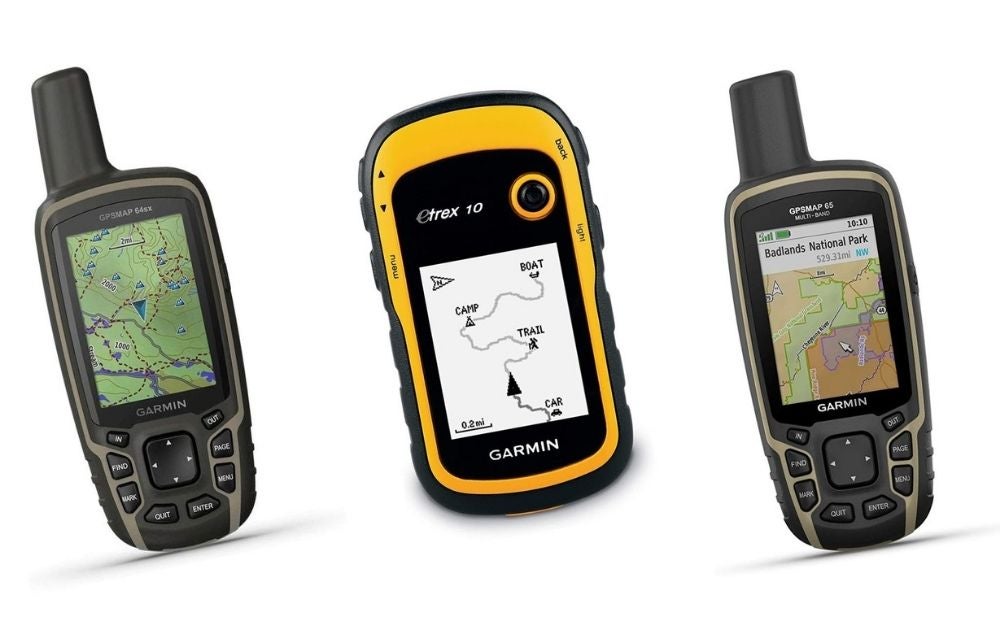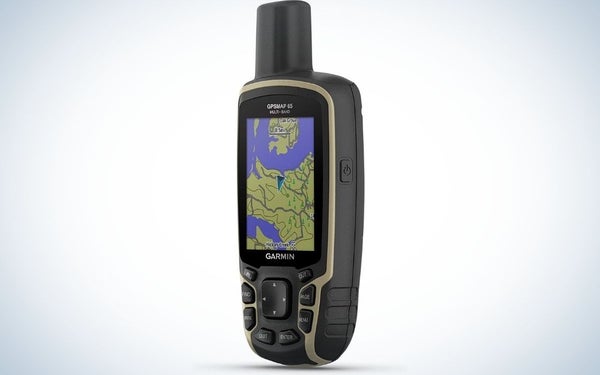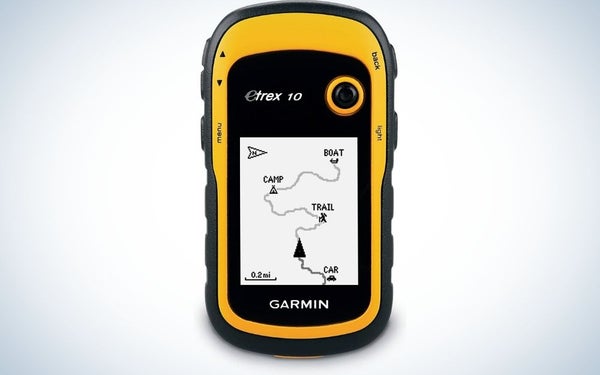| Entry Level Handheld GPS |
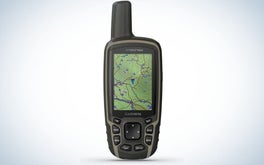
|
Garmin GPSMAP 64sx | SEE IT |
LEARN MORE
|
Summary
This Garmin GPS unit will do everything you need, from pinpointing your location to sending/receiving emails and text messages with family and friends. |
| Best Hiking GPS |
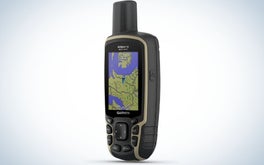
|
Garmin GPSMAP 65s | SEE IT |
LEARN MORE
|
Summary
Ruggedly built with easy-to-navigate controls, this is the best hiking GPS device on the market today. |
| Best Budget GPS |
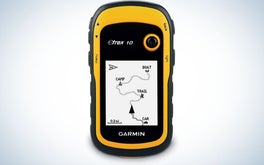
|
Garmin eTrex 10 | SEE IT |
LEARN MORE
|
Summary
This is the perfect handheld GPS device for those who don’t need a lot of fancy bells and whistles. |
While most modern cell phones will have some handheld GPS capability, if you’re serious about navigation, you’ll want to invest in a standalone unit. GPS stands for Global Positioning System. It relies on coordination between 31 different satellites in orbit around the Earth. The receiver, your GPS device, takes in data sent by the satellites that are within range, then translates that into your real-time location.
Knowing your exact position will help you plot a route back home or to your campsite. Alternatively, if you’re stranded and unable to move easily, such as due to an injury, those GPS coordinates will allow rescuers to find you easily. Suffice to say that a handheld GPS device is worth investing in if you spend much time in the field.
- Best for Beginners: Garmin GPSMAP 64sx
- Best for Hiking: Garmin GPSMAP 65s
- Best Budget: Garmin eTrex 10
How We Chose The Best Handheld GPS Devices
We examined dozens of different GPS units to narrow down our selections. Garmin is easily the most well-known and well-respected name in the GPS niche, and for good reason. They’ve been at this for a number of years and have perfected the technology being used. Naturally, our focus was on their lineup.
As someone who spends countless days a year in the field, I know firsthand how important it can be to have a foolproof and reliable method of finding your way home, to camp, or otherwise to a safe location. There are three factors I used in determining which products to recommend.
- Value: Each handheld GPS device had to provide significant value for the price
- Reliability: Garmin’s reputation is stellar in the GPS arena, but even so, some products are proven to work better than others.
- Features: I wanted to provide a small range of products, including units that have a lot of fun bells and whistles, as well as a base model that will keep you on the trail without complicated additional options.
The Best Handheld GPS Devices: Reviews & Recommendations
Entry for Beginners: Garmin GPSMAP 64sx
Why it Made the Cut: This Garmin GPS unit will do everything you need, from pinpointing your location to sending/receiving emails and text messages with family and friends.
Key Features
- Pre-loaded with TopoActive maps
- Wireless connectivity with Bluetooth
- Battery life: 16 hours
Pros:
- Supports satellite imagery, so you can truly see your area
- Has 8GB onboard memory, expandable with microSD
- Has 2.6” sunlight-readable full color display
Cons:
- Does not have a touchscreen
This Garmin GPS device is loaded with great features, making it an excellent choice for both entry-level consumers and those looking for an upgraded handheld GPS. The pre-loaded TopoActive maps have routable streets and trails, making it easy to plot and follow your path. Natural features, as well as buildings and more, are visible. There are also thousands of points of interest included. The controls are intuitive, with a very shallow learning curve before you’re ready to head for the great outdoors.
It has an 8-megapixel camera, so you can geotag photos as you move along. You can share waypoints, routes, and more wirelessly with other compatible devices. For example, if you find a great geocache, you can just press “Send” to transmit your information to another Garmin device.
This unit allows you to engage in geocaching in a paperless manner. You simply upload the GPX files directly to the device, and you’ll be able to read the description, hints, and so much more. You can also trade emails and messages between paired devices, so you can keep in touch with other members of your party during your trip.
Best for Hiking: Garmin GPSMAP 65s
Why it Made the Cut: Ruggedly built with easy-to-navigate controls, this is the best hiking GPS device on the market today.
Key Features
- Multi-band technology and GNSS satellite support
- Built-in navigation sensors
- Barometer to monitor weather
Pros:
- Up to 16 hours battery life
- Displays federal public land boundaries
- MicroSD slot for expanded data storage
Cons:
- Pricey for those just looking to get started
This unit is equipped with a large, 2.6-inch screen that is not only full-color but easily visible in the bright sun. What’s the point of having an outdoor GPS unit if you can’t see it outdoors? Garmin utilizes three sensors to pinpoint location and movement.
- Altimeter: provides elevation data and measures ascent or descent
- Barometer: tracks air pressure and can be used to predict weather changes
- Compass: tracks your direction of travel.
Combine the ABC sensors and couple them with satellite signals, and the device will know precisely where you are at all times.
Because it will access multiple navigation satellite systems, from GPS to GLONASS and more, you’ll be able to track even in more difficult areas. It will receive multiple frequencies, which in turn will enable improved position accuracy. Some of the technology used was previously only available to the military. It will also display the boundaries for federal public lands, enabling you to avoid trespassing on private property and getting into trouble with landowners. Toss this handheld GPS device in with your camping gear, and you’ll be ready for any trip you want to take.
Best Budget: Garmin eTrex 10
Why it Made the Cut: This is the perfect handheld GPS device for those who don’t need a lot of fancy bells and whistles.
Key Features
- Worldwide basemap preloaded
- Battery life: 25 hours
- Operates well even in deep canyons
Pros:
- Easy to read in any light
- Built to withstand rough conditions
- Budget-friendly without sacrificing quality
Cons:
- Monochrome display
It might not have a color display, two-way communication, or some of the other fancy features common to higher-priced handheld GPS devices, but this one has it where it truly counts. The screen is monochromatic, but you can easily see it no matter how bright it is outside. On top of that, it is built to withstand water, wind, humidity, dirt, and just about anything else Mother Nature wants to throw at it. Plus, the bright yellow color will keep you from losing it if you set it down when you take a break on the trail.
The eTrex devices in the Garmin lineup can track both GPS and GLONASS satellites at the same time. This means it can use up to 24 satellites beyond GPS along. This translates to a time to “lock on” to a position about 20 percent faster than if it were using just GPS. With a battery life of about 25 hours, you’ll have plenty of time to find your way back to camp with power to spare. It has a user-friendly layout, too, so you can get up and running quickly, learning as you move along. You can even program different profiles, so you can easily switch between geocaching and navigating your trail.
What to look for in the best handheld GPS devices?
When you’re shopping for the best handheld GPS device, there are several considerations to keep in mind. The first is budget. Most of us aren’t independently wealthy, so we need to plan our purchases carefully. You probably don’t need to spend as much as you think to secure a GPS device that will meet your requirements.
Next on the list is how you plan to use the GPS navigator. While it might be essential for camping, you may not need as many bells and whistles as you would for, say, a thru-hike on a major trail that runs through multiple states. Also, if you plan to do any geocaching, that’s a little different than just navigating from Point A to Point B.
Where you’ll be traveling, specifically the terrain is one more consideration on the list. Some budget GPS devices don’t work as well in deep canyons or in urban areas, as dense structures around you can block signals. Higher-quality handheld GPS devices aren’t troubled by those conditions as much. However, if you’ll be sticking to less mountainous areas of the country, a high-end handheld GPS device might not be necessary.
FAQs
Q: How do I choose a GPS?
Choosing a GPS depends upon several factors. Realistically, what it boils down to is what you truly need in a portable GPS unit. Most people need it to get them from one point to another and possibly check out some geocache locations along the way. There are tons of bells and whistles that make things easier or more efficient, but those will add to your final cost.
Q: How accurate are handheld GPS devices?
As a general rule of thumb, most commercial-grade GPS devices are accurate to about three meters or about ten feet. While this isn’t exactly pinpoint accuracy, it is perfectly acceptable for most civilian uses.
Q: What is the easiest handheld GPS to use?
The unit with the shortest learning curve on our list is the eTrex 10. It has the fewest features you’ll need to learn before putting it into use. However, you’re also sacrificing color display and some other features that, while not absolutely necessary, can make things easier to follow and understand.
Final Thoughts on the Best Handheld GPS Devices
The choice of the best handheld GPS device doesn’t boil down to any sort of one-size-fits-all decision. What works best for one person might be too complex or too expensive for the next. However, remember that having additional features you rarely use is better than needing those features but not having them available. Give serious thought about what you need your GPS unit to do and where you’ll be using it most often. Then, read GPS reviews of the units we’ve recommended here and see what others have to say about them. Once you have a good handle on what each unit will do for you, select the one that best fits your budget without sending your wallet into a tailspin. After getting it home, read the instructions fully, take it outside and start practicing with it. Take it on short trips around your neighborhood to test out the various features and learn how to use them to your best advantage.
